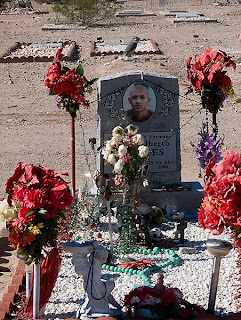 Camels in Arizona? You bet! In 1856, 33 camels, later joined by an additional 41, came to call Arizona home. The Camel Corps, as they were known, were part of a freighting experiment thought up by Jefferson Davis, the Secretary of War who was later to become the President of the Confederacy. But how would Americans know how to care for camels? Probably they wouldn't, so with the camels came an Arab camel herder named Haiji Ali, whose name was immediately anglicized to "Hi Jolly." When the Civil War broke out, the war department abandoned both the freighting experiment and the camels, leaving the latter to roam the desert on their own. Hi Jolly died in 1902, and is buried in this tomb in Quartszite. Presumably the camels all died, too.
Camels in Arizona? You bet! In 1856, 33 camels, later joined by an additional 41, came to call Arizona home. The Camel Corps, as they were known, were part of a freighting experiment thought up by Jefferson Davis, the Secretary of War who was later to become the President of the Confederacy. But how would Americans know how to care for camels? Probably they wouldn't, so with the camels came an Arab camel herder named Haiji Ali, whose name was immediately anglicized to "Hi Jolly." When the Civil War broke out, the war department abandoned both the freighting experiment and the camels, leaving the latter to roam the desert on their own. Hi Jolly died in 1902, and is buried in this tomb in Quartszite. Presumably the camels all died, too.
The cemetery in which Hi Jolly is buried has been used for decades for Quartzsite burial. Lush green cemeteries are not practical here, for water is expensive and difficult to find. Everything is rock, baked to a dark brown patina by the relentless sun. Grave sites would be lost in the sameness of the land without being marked somehow, and the logical marking material is what is on hand -- the outlines and decorations of the graves here are primary rocks and stones, although some have borders of paving stones or small fences. A few slabs are scattered throughout the cemetery, complete with circular holes just the right size to place an empty pickle jar that can later be filled with flowers. In a few places, the only indication that a grave was there was a slightly higher mound of gravel and stone, with, perhaps, 2 pieces of scrap metal screwed together to form a cross. Here are some images of the cemetery:







2 comments:
That's one gaudy pyramid Hi Jolly has got. Amusing.
As for the camels -- they did the same thing (introduce camels) in Australia for the same reason. However, there they excaped and started breeding. Today, there are more wild camels in Australia than anywhere else on Earth. They have become a major ecological problem. So it looks like Arizona lucked out.
Post a Comment